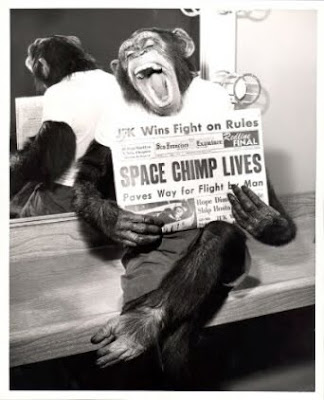In Russia, if had there been no space dogs, there would have been no orbiting Yuri. Meanwhile in America... no monkeys or apes? No Shepard or Glenn. It's that simple.
Many people are surprised to find that "space monkeys" preceded the official establishment of our space program by over a decade. In 1948, NASA didn’t exist yet, but launching macaques (Rhesus monkeys) past Earth's atmosphere with V2 rockets did. Cynomolgus and Squirrel Monkeys followed in the 1950s-60s. Each attempt measured vital signs of the monkeys in different positions, in order to examine biological effects of space travel, though few had happy endings.
Like the dogs, this is another one of those posts where I won't go too in-depth… there are entirely too many monkeys for a narrative, and there are already many pages out on the web that detail their stories. I'd be just another re-hashing spot. So, I'll stick with the Greatest Hits and simply pepper the post with links to further study for those who are interested in delving deeper.

Able and Miss Baker at 1959 Press Conference.
Click to see their LIFE MAGAZINE cover
Click to see their LIFE MAGAZINE cover
1940s: In June 1949, American macaque Albert II became the first monkey to officially reach "space" when his rocket reached 134 km (83 miles) -- past the now-internationally recognized Kármán line of 100 km (62 miles).
1950s: In May 1959, the big stars in the news were Able and Miss Baker, the first two monkeys (rhesus and squirrel, respectively) to return safely to Earth, having actually survived space flight at an altitude of 579km (360 miles). In December of the same year, SAM the rhesus monkey was the next Mercury subject to capture headlines, though his flight only reached 53 miles.

Primates, unlike many other animals, can be trained to look as
if they are actually enjoying all this space-training nonsense!
if they are actually enjoying all this space-training nonsense!
Early 1960s: In January 1961, HAM the chimpanzee was the first ape in space, having been chosen as the best trainee among 40 potential astro-chimps. He was the first to be trained to operate levers inside the space craft, a crucial step that demonstrated the ability to perform tasks in weightlessness.
Just over 3 months later, Alan Shepard went into space, and he was none too happy about sharing the spotlight with an ape!
In November of that same year, Enos the chimpanzee because the first ape to orbit Earth, followed closely by John Glenn, who handled the situation a bit more deftly by poking fun at both himself and the primate who "beat him to the punch and probably flew the craft better."
Late 1960s: France launched two pig-tailed macaque named Martine and Pierette on Vestas rocket in March of 1967. The US launched the macaque, Bonny, in 1969.
1970s: No monkey business.

1980s: The first Soviet monkeys to fly were placed aboard Kosmos-1514 in 1983, nearly 22 years after they had already flown humans Throughout the 80s and 90s, Russia sent 12 Rhesus monkeys into space on various other BION missions -- two of whom, Zhakonya and Zabiyaka, hold the "monkey endurance" record at 14 days in space -- and NASA included two on STS-51-B inside SpaceLab 3.
See the NASA archives for details of all the monkey’s and chimp’s stories. Don't miss the single most interesting (IMHO) document scanned into the archives, describing the Results of the Project Mercury Ballistic and Orbital Chimpanzee Flights, including craft specifications, task consoles, restraint systems, bio-instrumentation, flight plans, flight results, and medical monitoring.




